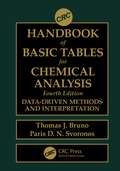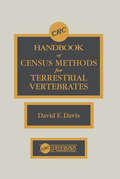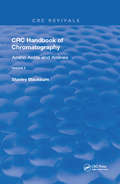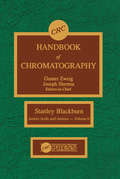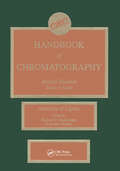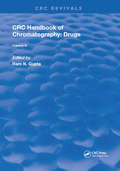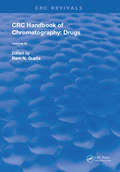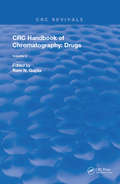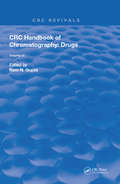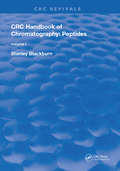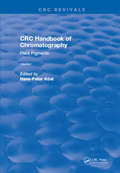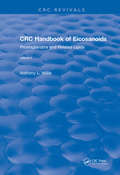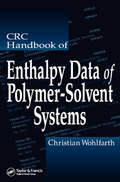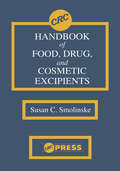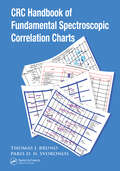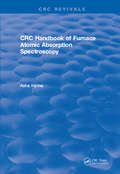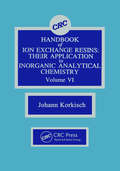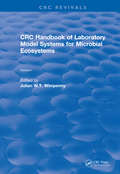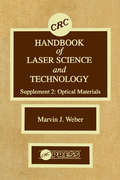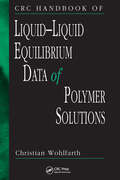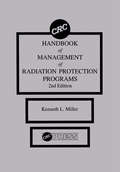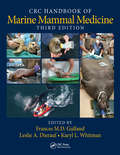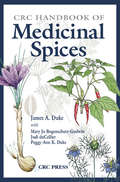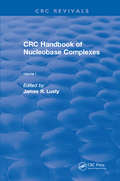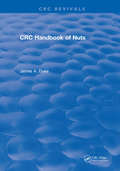- Table View
- List View
CRC Handbook of Basic Tables for Chemical Analysis: Data-Driven Methods and Interpretation
by Thomas J. Bruno Paris D.N. SvoronosResearchers in chemistry, chemical engineering, pharmaceutical science, forensics, and environmental science make routine use of chemical analysis, but the information these researchers need is often scattered in different sources and difficult to access. The CRC Handbook of Basic Tables for Chemical Analysis: Data-Driven Methods and Interpretation, Fourth Edition is a one-stop reference that presents updated data in a handy format specifically designed for use when reaching a decision point in designing an analysis or interpreting results. This new edition offers expanded coverage of calibration and uncertainty, and continues to include the critical information scientists rely on to perform accurate analysis. Enhancements to the Fourth Edition: Compiles a huge array of useful and important data into a single, convenient source Explanatory text provides context for data and guidelines on applications Coalesces information from several different fields Provides information on the most useful "wet" chemistry methods as well as instrumental techniques, with an expanded discussion of laboratory safety Contains information of historical importance necessary to interpret the literature and understand current methodology. Unmatched in its coverage of the range of information scientists need in the lab, this resource will be referred to again and again by practitioners who need quick, easy access to the data that forms the basis for experimentation and analysis.
CRC Handbook of Census Methods for Terrestrial Vertebrates
by David E DavisLearn how to start a census program for terrestrial vertebrates with this handbook. Whether the information you need is for managing a population, surveying environmental impact, or conducting research on a particular species, this handbook has it all. Principles, methods, and calculations are explained. The following information is given for each species: name; range; reasons for census; life history; items of importance, e.g., migration; methods of census; recent and pertinent references; and comments about the various methods.
CRC Handbook of Chromatography: Amino Acids and Amines, Volume II
by Ram N. GuptaThese volumes provide a reference source of different gas chro-matographic, liquid chromatographic, or thin-layer chromatographic techniques for the qualitative determination of various therapeutic agents, including antibiotics, vitamins and hormones, drugs of abuse in body fluids, dosage forms, or food stuffs. Over 5000 publi-cations were reviewed to prepare tables of chromatographic data for 800 compounds, arranged alphabetically by generic drug name or by drug groups. A detailed summary of the extraction procedure de-scribed in each publication included in the table of a particular drug is also provided. This easy-to-read handbook is useful for se-lecting an appropriate chromatographic procedure for the determi-nation of a given compound according to the available facilities.
CRC Handbook of Chromatography: Amino Acids and Amines, Volume II
by S. BlackburnAn in-depth analysis of chromatography literature and procedures since 1981 is presented in this publication. Featured is a compre-hensive range of tables relating to the chromatographic separation and determination of amino acids, amines, and their derivatives. Methods of sample preparation and derivatization and methods of detection are described. Included are techniques for the liquid and gas chro-matographic separation of free amino acids and their derivatives, including o-phthalaldehyde, dansyl, and phenylthiolaydantoin deriva-tives. The separation of amino acid enantiomers is also described. This book will be invaluable to chemists, biochemists, and analysts involved in the separation and determination of amino acids or amines and their derivatives.
CRC Handbook of Chromatography: Analysis of Lipids (Handbook of Chromatography)
by Kumar D. Mukherjee Nikolaus WeberHandbook of Chromatography: Analysis of Lipids provides a valuable review of state-of-the-art applications of chromatographic techniques (TLC, GC, HPLC) and other analytical techniques. Much of this volume is devoted to applications of HPLC (including supercritical fluid chromatography) in the analysis of lipids such as fatty acids, oxygenated fatty acids, enantiomeric acyl- and alkylglycerols, and lipoproteins. The handbook also provides extensive coverage of applications of combinations of various chromatographic techniques used in the analysis of ozonides, anacardic acids, glycerophospholipids, products of lipolysis, artifacts and contaminants in edible fats, acylated proteins, non-caloric lipids, lipophilic vitamins, acyl-Coenzyme A thioesters, dolichols, mycolic acids, technical fats and fat products, and liposomes. Handbook of Chromatography: Analysis of Lipids will be a useful reference for oil chemists, biochemists, fat science technologists, and other scientists involved in lipid research.
CRC Handbook of Chromatography: Drugs, Volume III (Handbook Of Chromatography Ser. #2)
by Ram N. GuptaThese volumes provide a reference source of different gas chro-matographic, liquid chromatographic, or thin-layer chromatographic techniques for the qualitative determination of various therapeutic agents, including antibiotics, vitamins and hormones, drugs of abuse in body fluids, dosage forms, or food stuffs. Over 5000 publi-cations were reviewed to prepare tables of chromatographic data for 800 compounds, arranged alphabetically by generic drug name or by drug groups. A detailed summary of the extraction procedure de-scribed in each publication included in the table of a particular drug is also provided. This easy-to-read handbook is useful for se-lecting an appropriate chromatographic procedure for the determi-nation of a given compound according to the available facilities.
CRC Handbook of Chromatography: Drugs, Volume IV (Handbook Of Chromatography Ser. #2)
by Ram N. GuptaThese volumes provide a reference source of different gas chro-matographic, liquid chromatographic, or thin-layer chromatographic techniques for the qualitative determination of various therapeutic agents, including antibiotics, vitamins and hormones, drugs of abuse in body fluids, dosage forms, or food stuffs. Over 5000 publi-cations were reviewed to prepare tables of chromatographic data for 800 compounds, arranged alphabetically by generic drug name or by drug groups. A detailed summary of the extraction procedure de-scribed in each publication included in the table of a particular drug is also provided. This easy-to-read handbook is useful for se-lecting an appropriate chromatographic procedure for the determi-nation of a given compound according to the available facilities.
CRC Handbook of Chromatography: Drugs, Volume V (Handbook Of Chromatography Ser. #2)
by Ram N. GuptaThese volumes provide a reference source of different gas chromatographic, liquid chromatographic, or thin-layer chromatographic techniques, for the qualitative determination of various therapeutic agents, including antibiotics, vitamins and hormones, drugs of abuse in body fluids, dosage forms, or food stuffs. Over 5000 publications were reviewed to prepare tables of chromatographic data for 800 compounds, arranged alphabetically by generic drug name or by drug groups. A detailed summary of the extraction procedure described in each publication included in the table of a particular drug is also provided. This easy-to-read handbook is useful for selecting an appropriate chromatographic procedure for the determination of a given compound according to the available facilities.
CRC Handbook of Chromatography: Drugs, Volume VI (Handbook Of Chromatography Ser. #2)
by Ram N. GuptaThese volumes provide a reference source of different gas chro-matographic, liquid chromatographic, or thin-layer chromatographic techniques for the qualitative determination of various therapeutic agents, including antibiotics, vitamins and hormones, drugs of abuse in body fluids, dosage forms, or food stuffs. Over 5000 publi-cations were reviewed to prepare tables of chromatographic data for 800 compounds, arranged alphabetically by generic drug name or by drug groups. A detailed summary of the extraction procedure de-scribed in each publication included in the table of a particular drug is also provided. This easy-to-read handbook is useful for se-lecting an appropriate chromatographic procedure for the determi-nation of a given compound according to the available facilities.
CRC Handbook of Chromatography: Volume I: Peptides
by Ram N. GuptaThese volumes provide a reference source of different gas chromatographic, liquid chromatographic, or thin-layer chromatographic techniques for the qualitative determination of various therapeutic agents, including antibiotics, vitamins and hormones, drugs of abuse in body fluids, dosage forms, or food stuffs. Over 5000 publications were reviewed to prepare tables of chromatographic data for 800 compounds, arranged alphabetically by generic drug name or by drug groups. A detailed summary of the extraction procedure described in each publication included in the table of a particular drug is also provided. This easy-to-read handbook is useful for selecting an appropriate chromatographic procedure for the determination of a given compound according to the available facilities.
CRC Handbook of Chromatography: Volume I: Plant Pigments (CRC Press Revivals)
by Hans-Peter KostThe CRC Handbook of Chromatography is a series of work-bench references for scientists and researchers using chromatographic systems for the analysis of organic and inorganic compounds.This handbook is an assemblage of tables where, besides data obtained by modern separation methods, older sources often difficult to access have been included to give maximum information. For use in scientific research and routine analysis where the exact determination of plant pigments, because of their light absorbing properties and defined tasks, is necessary.
CRC Handbook of Eicosanoids, Volume II: Prostaglandins and Related Lipids (CRC Press Revivals)
by A. L. WillisBuilding upon the extensive compilation of biochemical data featured in Volume I of the Handbook of Eicosanoids, the new Volume II describes the past, present, and potential future impact of eicosanoid research on new drug development. The reader is taken from a historical perspective through state-of-the-art basic concepts to extensive tabulation of molecular structures of compounds known to act via the eicosanoid system. Much emphasis is given to recent breakthroughs in the mechanism of action of anti-inflammatory corticosteroids and the development of receptor antagonists for prostaglandins and leukotrienes. There is also an introductory chapter that proposes areas that require further investigation and novel approaches using existing technology. This handbook will thus be invaluable for medicinal chemists, pharmacologists, and all those involved in basic research in the eicosanoid area. In addition, many parts of this handbook are suitable for use by university lecturers and students. There are 20 figures and 44 extensive tables as well as a bibliography containing more than 2,000 references that complement the text.
CRC Handbook of Enthalpy Data of Polymer-Solvent Systems
by Christian WohlfarthThe CRC Handbook of Enthalpy Data of Polymer-Solvent Systems presents data that is as essential to the production, process design, and use of polymers as it is to understanding the physical behavior and intermolecular interactions in polymer solutions and in developing thermodynamic polymer models. Providing an all-encompassing collection
CRC Handbook of Food, Drug, and Cosmetic Excipients
by Susan C. SmolinskeCRC Handbook of Food, Drug, and Cosmetic Excipients provides a comprehensive summary of toxicological issues regarding inactive ingredients in pharmaceutical products, cosmetic products, and food additives. Background information on regulations and labeling requirements for each type of product is provided, and 77 articles critically review human and animal data pertinent to a variety of agents and makes judgments regarding the clinical relevance. The book also identifies at-risk populations, such as neonates, patients with renal failure, and atopic patients. Inactive common pharmaceutical agents and/or foods containing certain ingredients are listed to help physicians counsel hypersensitive patients who must avoid products containing these excipients.
CRC Handbook of Fundamental Spectroscopic Correlation Charts
by Thomas J. Bruno Paris D.N. SvoronosFrom forensics and security to pharmaceuticals and environmental applications, spectroscopic detection is one of the most cost-effective methods for identifying chemical compounds in a wide range of disciplines. For spectroscopic information, correlation charts are far more easily used than tables, especially for scientists and students whose own a
CRC Handbook of Furnace Atomic Absorption Spectroscopy (CRC Press Revivals)
by Asha VarmaThis book addresses Furnace Atomic Absorption Spectroscopy (FAAS), which has gained worldwide acceptance as an analytical technique. FAAS offers 100-1000 times better determination and detection limits than other techniques for a majority of the elements. This technique requires a small sample size, and demands less sample-preparation time than others. The handbook is a collection of thousands of references for detection and determination of various elements in agricultural products, biological and clinical samples, and metallurgical and electronic materials. Each chapter is devoted to an element or a similar group of elements. Included are instrumental setup parameters, references, and author and subject indexes. Also presented are detailed appendixes covering glossary, list of manufacturers of spectrophotometers and its accessories, list of chemical suppliers, and list of reviews and abstracts. The handbook covers topics such as heavy metals, clinical products, and trace metal analysis. This desk-top reference is meant for chemists who handle day-to-day analysis problems in laboratories in government, clinical, industrial and academic settings. It is invaluable for those involved in research in environmental science, analytical chemistry, clinical chemistry and forensic science.
CRC Handbook of Ion Exchange Resins, Volume VI: Their Application To Inorganic Analytical Chemistry
by Johann KorkischThe six-volume CRC Handbook of Ion Exchange Resins reviews the application of ion exchange resins to inorganic analytical chemistry. Extracted from over 6,000 original publications, it presents the information in over 1,000 tables complemented by concise descriptions of analytical methods involving virtually all the elements of the periodic table. Also, the ion exchange characteristics of the elements, as well as other important information required by analysis using ion exchange resins, are presented in separate tables. The methods that allow the multi-element analysis of complex matrices are emphasized. This work includes a general discussion of the theoretical, instrumental, and other principles underlying the various applications of ion exchange resins in inorganic analytical chemistry with special attention focused on techniques based on ion chromatography.
CRC Handbook of Laboratory Model Systems for Microbial Ecosystems, Volume I (CRC Press Revivals)
by Julian W.T. WimpennyThese volumes present the main classes of useful laboratory model systems used to study microbial ecosystems, with emphasis on the practical details for the use of each model. The most commonly used model, the homogeneous fermenter, is featured along with linked homogeneous culture systems, film fermenters, and percolating columns. Additionally, gel-stabilized culture systems which incorporate molecular diffusion as their main solute transfer mechanism and the microbial colony are explained. Chapters comparing model systems with "microcosms" are included, along with discussions of the value of computer models in microbial ecosystem research. Highlighted is a global discussion of the value of laboratory models in microbial ecology.
CRC Handbook of Laser Science and Technology Supplement 2: Optical Materials (Laser And Optical Science And Technology Ser. #8)
by Marvin J. WeberIn the CRC Handbook of Laser Science and Technology: Supplement 2, experts summarize the discovery and properties of new optical materials that have appeared since the publication of Volumes III-V. Included are the latest advances in optical crystals, glasses and plastics, laser host materials, phase conjugation materials, linear electrooptic materials, nonlinear optical materials, magnetooptic materials, elastooptic materials, photorefractive materials, liquid crystals, and thin film coatings. The book also includes expanded coverage of optical waveguide materials and new sections on optical liquids, glass fiber lasers, diamond optics, and gradient index materials. Appendices include Designation of Russian Optical Glasses; Abbreviations, Acronyms, and Mineralogical or Common Names for Optical Materials; and Abbreviations for Methods of Preparing Optical Materials. Extensive tabulations of materials properties with references to the primary literature are provided throughout the supplement. The CRC Handbook of Laser Science and Technology: Supplement 2 represents the latest volume in the most comprehensive, up-to-date listing of the properties of optical materials for lasers and laser systems, making it an essential reference work for all scientists and engineers working in laser research and development.
CRC Handbook of Liquid-Liquid Equilibrium Data of Polymer Solutions
by Christian WohlfarthThermodynamic data form the basis for separation processes used in different fields of science and industry, from specialty chemicals to foods and pharmaceuticals. One obstacle to developing new production processes, products, or optimization is the lack, or inaccessibility, of experimental data related to phase equilibrium.Access More Than 1200 Data Sets, Including 810 Binary Systems, 325 Ternary Systems, and 25 Quaternary (or Higher) SystemsThe CRC Handbook of Liquid-Liquid Equilibrium Data of Polymer Solutions provides a thorough and up-to-date compilation of experimental liquid-liquid equilibrium (LLE) data and their original sources. Arranged in a consistent format, the handbook provides convenient access to cloud-point and coexistence data as well as upper and lower critical solution temperatures and important demixing data for each system.An Excellent Companion to the Author’s Previous Collections of Thermodynamic Data!While the author’s previous data compilations center around specific types of polymer systems, Wohlfharth’s latest work distinguishes itself by focusing instead on representing LLE data for all types of polymer systems in a single source.
CRC Handbook of Management of Radiation Protection Programs, Second Edition
by Kenneth L. MillerCRC Handbook of Management of Radiation Protection Programs, 2nd Edition, is unique in that it offers practical guidance for managing various aspects of radiation protection programs ranging from the daily operation of a health physics office to the preparation of radiation experts for court appearances as professional witnesses. The book also covers such topics as organization and management of nonionizing radiation safety programs (with special emphasis on laser safety programs) and management of radioactive waste, personnel monitoring programs, radiation accident victims, internal exposure, relative radiotoxicity and radiation therapy patients. Other chapters discuss handling radiation accidents and education and training requirements for radiation protection. Legal aspects covered in the book include the history of radiation court cases, legal implications of record keeping, and preparation for court appearances. CRC Handbook of Management of Radiation Protection Programs, 2nd Edition will be a valuable reference resource for medical and health physicists, industrial hygienists, physicians, nuclear engineers, radiation protection regulators, radiation emergency management agents, radiation safety committees, and managers of facilities using ionizing and nonionizing radiation sources.
CRC Handbook of Marine Mammal Medicine
by Frances M.D. Gulland Leslie A. Dierauf Karyl L. WhitmanAAP Prose Award Finalist 2018/19 Key features: Covers all aspects of marine mammal veterinary practice Written by internationally acknowledged experts Adds new chapters on Ophthalmology, Dentistry, Ethics, Oil Spill Response, Health Assessments, Whale Entanglement Response, Dive Response, and Biotoxins Richly illustrated in color throughout the new edition including updated anatomical drawings and extensive photographs of ocular lesions Provides guidance to websites that regularly present updated information and images pertinent to current marine mammal medicine such as imaging and stranding network contacts Discusses ethics and animal welfare For three decades, this book has been acknowledged as the most respected scientific reference specifically devoted to marine mammal medicine and health. Written by approximately 100 contributors who are recognized globally as leaders in their respective fields, the CRC Handbook of Marine Mammal Medicine, Third Edition continues to serve as the essential guide for all practitioners involved with marine mammals including veterinarians, technicians, biological researchers, students, managers, keepers, curators, and trainers. The 45 chapters provide essential information for the practitioner on pathology, infectious diseases, medical treatment, anesthesia, surgery, husbandry, health assessment, species-specific medicine, medically pertinent anatomy and physiology, and global health concerns such as strandings, oil spills, and entanglements of marine mammals. The book guides the reader through the veterinary care of cetaceans, pinnipeds, manatees, sea otters, and polar bears. In addition to summaries of current knowledge, chapters provide information on those digital resources and websites which present the latest information as it emerges in the field. The CRC Handbook of Marine Mammal Medicine, Third Edition gives a call to action for scientists to experiment with new endeavors to engage and inspire current and future generations to care for marine mammals and the marine environment, and work together to find solutions. As the most trusted reference for marine mammal conservation medicine and for marine mammal medical facilities around the world, this book needs to be in your library.
CRC Handbook of Medicinal Spices
by James A. Duke Mary Jo Bogenschutz-Godwin Judi DuCellier Peggy-Ann K. Duke"Let food be your medicine, medicine your food."-Hippocrates, 2400 B.C.When the "Father of Medicine" uttered those famous words, spices were as important for medicine, embalming, preserving food, and masking bad odors as they were for more mundane culinary matters. Author James A. Duke predicts that spices such as capsicum, cinnamon, garlic, ginger
CRC Handbook of Nucleobase Complexes: Transition Metal Complexes Of Naturally Occurring Nucleobases And Their Derivatives (CRC Press Revivals)
by James R. LustyThe purpose of this easy-to-use handbook is to provide a quick, accessible reference to nucleobase complexes. It describes these complexes with reference to methods of preparation, their characterization, and their toxicity and therapeutic indices. It lists the modes of coordination together with the relevant spectral data and major methods of investigation. This concise resource guide also includes data on the uncomplexed bases, such as solubility, pk, accepted structures in the solid state and solutions, and the natural occurrence of the base. Investigators in the fields of transition metal chemistry, biological inorganic chemistry and those working in medical laboratories will find this handbook indispensable.
CRC Handbook of Nuts
by James A. DukeOver one hundred of the world's most important species of nuts are systematically accounted in this informative handbook. The text defines nuts and discusses their economic and nutritional value. For easy reference; there is an illustrated account of each nut by species, arranged alphabetically by scientific name. Each account includes the family name, several colloquial names, and paragraphs on uses, folk medicine, chemistry, germplasm, distribution, ecol-ogy, cultivation, harvesting, yields, energy, and biotic factors.Chapters Describe:UsesFolk medicineChemistryGermplasmDistributionEcologyCultivationHarvestingYields and economicsEnergyBiotic factors
